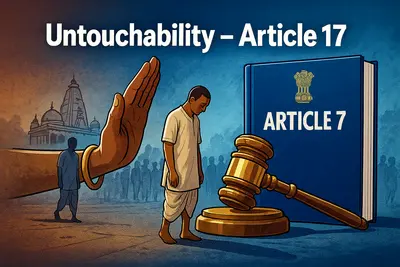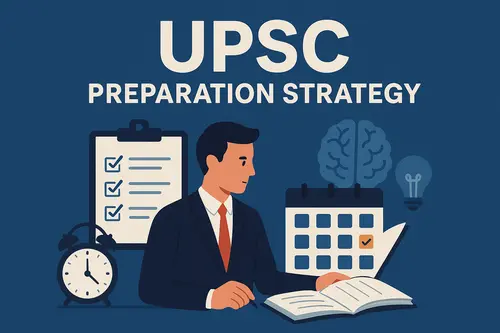
"Untouchability shuts all doors of opportunities for betterment in life for Untouchables. It does not offer an Untouchable any opportunity to move freely in society; it compels him to live in dungeons and seclusion; it prevents him from educating himself and following a profession of his choice."
- Dr. B.R. Ambedkar (Chairman of the Drafting Committee)
Introduction: Untouchability in Contemporary India
After more than 70 years of constitutional protection, caste discrimination continues in both subtle and overt ways, which can vary from exclusion from society, refusal of access, violence and humiliation.
The ongoing debate regarding the Karnataka caste census (2025) and the growing demand for a caste-based census at the national level has therefore reignited discussions around social justice, representation, and equality. Moreover,discussions underscored how entrenched caste identity still plays an important role in opportunity in contemporary India. Consequently, the debate has significant implications for policy-making and social reform.
According to the National Crime Records Bureau (NCRB, 2023):
- There were more than 57,000 cases registered under the Scheduled Castes and Scheduled Tribes (Prevention of Atrocities) Act.
- States like Uttar Pradesh, Rajasthan, and Madhya Pradesh reported the highest number of offenses.
- Only 35% of the cases resulted in conviction, highlighting a gap between constitutional parameters and ground realities.
In this context, Article 17 ought to serve as a timeless constitutional commitment- a “messiah” that envisioned an end to centuries of untouchability, human dignity restored, and India as a true egalitarian society.
Meaning of Article 17 in the Indian Constitution
“Untouchability is abolished and its practice in any form is forbidden.”
Article 17 of the Indian Constitution abolishes untouchability and prohibits its practice and makes any untouchability act, practice, or behavior a punishable offense. We can view this act not merely as a legal provision, but as a moral revolution that contradicts the historical continuities of deep-seated caste hierarchy.
- It will ensure that anyone will not be denied the privileges of the dignity of public places, services, or rights because of their caste or birth.
- This article imposes a legal obligation on the state to implement laws and create institutions to end caste-based discrimination.
- While this article is essentially about fundamental rights (Article 14–18), Article 17 also stands apart; it is absolute and unconditional for any justification or exception.
Also, authorities can legally enforce Article 17 through criminal law, specifically using the Protection of Civil Rights Act, 1955, and the SC/ST (Prevention of Atrocities) Act, 1989, even though it is non-justiciable in spirit.
In short, Article 17 took a centuries-old social stigma and turned it into a constitutional crime, it signifies the moral and democratic awakening of India.
Read Article 16 of the Indian Constitution
Legal Basis of Article 17
The drafters of the Constitution ensured that Article 17 would not just be an ideal—the situation would have to be real. Parliament legislated two important and landmark laws in this regard, which operationalized the abolition of untouchability and the protection of disadvantaged communities.
(a) The Protection of Civil Rights Act, 1955
The Protection of Civil Rights Act (1955) was the first major step to give dimensionality to Article 17. It legally transformed a moral declaration against untouchability into an actionable device of legal protection.
Salient Features:
It specifically punishes any act of discrimination, action or threat on the basis of caste, denying or restricting access and use of a public place or public service.
Offences include:
- Firstly, Refusal to permit access to temples, educational institutions, places open to the public.
- Secondly, Refusal to provide goods, services or premises in shops, hotels, restaurants, wells, etc.
- Thirdly, Enforcement of social segregation or excluding on the basis of caste in any other manner.
- The police can investigate offences under the Act on their own, and the law does not allow them to be settled outside the formal legal process, as these offences are cognizable and non-compoundable.
The court can sentence offenders of indictable offences to prison, with or without fines, depending on the severity of the act. Moreover, The Act laid the legal structure of equality, demonstrating that Article 17 holds meaning for everyday life.
(b) The Scheduled Castes and Scheduled Tribes (Prevention of Atrocities) Act, 1989
As untouchability continued in sharper and more vivid forms, therefore, a call for a stronger law was recognized.
Consequently, the SC/ST (Prevention of Atrocities) Act, enacted in 1989, became a concrete and comprehensive law to reinforce the constitutional armour of Article 17.
Objective:
To protect members of Scheduled Castes and Scheduled Tribes (SC/ST) from criminal acts of physical, social, and economic exploitation and guarantee justice, through special remedies and legal processes.
Recognized Offences Include:
- Publicly parading a person naked, or humiliating a person in public.
- Committing a social or economic boycott resulting in the effects of isolation from an entire community.
- Forcing families off the land or out of their home.
- Committing assault, abuse, or threatening a person based on their caste identity.
Important Provisions:
- Provides for Special Courts and exclusive Special Public Prosecutors for expeditious trial.
- Provides rehabilitation relief and compensation for the victim.
- Established non-bailable and cognizable offences, to reinforce the seriousness of the crime.
- Holds public officials accountable for negligence in investigating or preventing atrocities.
Therefore, this Act the State reaffirmed that equality and dignity are not relative rights, but the essence of the constitutional morality of India.
Enhancing the Law: Amendments of 2015 and 2018
Though the SC/ST (Prevention of Atrocities) Act, 1989 was a significant step toward the protection of vulnerable groups, its implementation has sometimes been problematic through delayed justice, misuse of process, and lack of accountability. In response to these issues, the Parliament introduced two important amendments that strengthened the provisions and the spirit of Article 17.
Highlights of the 2015 Amendment
The 2015 amendment to the Scheduled Castes and Scheduled Tribes (Prevention of Atrocities) Act made the law more responsive and victim-centred.
Key Changes Introduced:
- Expanded definition of atrocities: The definition now includes social and economic boycotts, humiliation, and forced eviction as crimes.
- Accountability of public servants: Public servants who do not perform their duties to prevent or investigate an atrocity are liable to prosecution.
- Special Courts exclusively trial: The law establishes special courts to conduct quick trials and deliver justice without undue delay.
- Anticipatory bail denied: Courts deny anticipatory bail when a prima facie case exists.
- Victim and witness protection: There are provisions for relief, compensation, and rehabilitation with reasonable timelines.
The legislature enacted these provisions to ensure that justice is served not only promptly but also equitably.
2018 Amendment
In 2018, the Supreme Court’s decision in Subhash Kashinath Mahajan v. State of Maharashtra drew widespread national condemnation. In that case, the Court ordered:
- A preliminary inquiry should be held before a FIR is registered.
- The accused must first obtain authorization from higher officials (including the DGP and Home Secretary) before arrest.
Critics denounced these orders for undermining the original intention of the Act and warned that they would cause many victims to abandon reporting crimes.
In reaction, Parliament passed the 2018 Amendment legislation, which —
- Rescinded the Supreme Court’s orders.
- Confirmed the strict form of the Act.
- Stated that:
o A preliminary inquiry was not necessary before FIR.
o Arrest would not require prior approval.
o The anticipatory bail sections of the CrPC would not be applicable to any offence under this Act.
It unambiguously reaffirmed the State’s fundamental commitment to the dignity and security of marginalized communities, which was the foundational purpose of Article 17.
Landmark Judicial Interpretations
The judiciary needed to denounce and issue orders to assist in interpreting the provisional agreement and associated legislation, and, wherever possible, to keep constitutional morality aligned with changes in social reality.
(a) State of Karnataka v. Appa Balu Ingale, 1993
The Supreme Court reaffirmed that Indian society cannot violate the equality and dignity of individuals under any circumstance, tradition, or custom, and that untouchability, in any form, is unconstitutional.
(b) Subhash Kashinath Mahajan v. State of Maharashtra (2018)
Initially, the Supreme Court tried to balance protecting the victims of untouchability with ensuring that people do not misuse the anti-untouchability legislation. People perceived some of its guidance, such as requiring a preliminary inquiry and prior permission before making an arrest, as undercutting the efficacy of the statute. Substantial protest followed these efforts which resulted in legislative correction through the 2018 Amendment.
(c) Union of India v. State of Maharashtra (2019)
The Supreme Court upheld the constitutionality of the 2018 Amendment, recognizing that the dignity of individuals and the goal of social justice outweighed the inefficiencies introduced by the procedural requirements. Though, This decision represented a significant win for the policy concern underpinning Article 17 and reaffirmed India’s commitment to ending caste-based oppression on Indian soil.
Challenges to Implementation
While the anti-untouchability laws are satisfactory and robust, enforcement of Article 17 faces challenges as it works to become the norm.
- Society deeply ingrains casteist beliefs, and people continue to act on them even though laws prohibit such actions.
- Victims Underreporting Crimes: Victims do not bank on the strength of law because of fear of intimidation or societal pressures.
- Low Conviction Rates: The deterrent of the law is diminished by delayed investigations and long trial times.
- Alleged Ethical Misuse of the Law: Occasionally there will be political or social narratives suggesting some kind of misuse of the SC/ST Act which raises questions about the way the law is applied, even though it is often misinformed, or even misleading of genuine cases.
These obstacles illustrate that any sort of legal protection, by itself, will not end untouchability, the local society must acknowledge its appropriateness is essential too.
Article 17 in Contemporary India
Article 17 is still considered an important constitutional principle in contemporary India and it remains a “living constitution,” recognizing several realities:
- Increased Awareness: Additionally, The role of education, media, and activism have helped bring awareness of the existence of caste discrimination, in all of its forms, into the public consciousness.
- Continued Violence: The systematic harassment, forcible economic depravity, and social boycotting of people continue to occur, especially in rural regions.
- Activist Movements: Movements such as “Dalit Lives Matter” have brought attention to and continue to remind the society of this existence and legitimacy of caste discrimination.
- Caste-Based Census or Surveys: The discussion around the caste-based survey in India/Karnataka, and the proposed data related to caste-influenced access to opportunities and social justice, continues to show how caste affects people’s reality.
In short, Article 17 is not only an important historic constitutional provision, but also particularly serves as a moral foundation towards developing an India where “equality”, “dignity”, and “inclusive development” are valued.
Relevance for UPSC
Why Article 17 is Important for UPSC Aspirants
Article 17 is part of the Fundamental Rights articulations in the Indian Constitution (Articles 14 – 18). It is situated in the Equality chapter of the Constitution.
Article 17 is directly tied to social justice, as well as affirmative action and governance ethics (both of which are ‘fair game’ for the GS2 and Essay papers).
Understanding Article 17 would be beneficial in answering other questions related to, constitutional morality, SC/ST Acts, and other contemporary socio-legal issues.
Examples of Past Exam Questions:
- UPSC 2022: “Which Amendment, article, abolishes untouchability in India?”
- UPSC 2018: “Discuss how the principle of equality enshrined in Articles 14 – 18 has been implemented in India.”
- UPSC 2020 (Essay): “Justice delayed is justice denied – comment with respect to marginalized communities.”
Current Relevance (2025):
The caste census discourse reinforces the relevance of caste in policy concerning social equity and reservation.
Therefore, The continuing gap of implementation between the principles of a constitutional state and its ground realization reinforces the need for judicial engagement and policy action.
The engagement of judicial activism and legal reform reaffirm that Article 17 is a living instrument of social justice rather than merely a reference point.
Conclusion: The Living Messiah
“The living spirit of Article 17 lies in not just punishing discrimination, but in removing discrimination and its texture from Indian society.” Article 17, along with the Protection of Civil Rights Act and the SC/ST (Prevention of Atrocities) Act serves as the moral and legal faculty to protect millions.
The success of Article 17 depends on legislation, but also on the social consciousness, awareness, education around caste relations, and active involvement in abolishing caste discrimination.
At its essence, Article 17 is merely a clause in the Constitution – it is India’s conscience in action to deliver dignity, equality, and justice for all.
FAQs Regarding Article 17 and the Practice of Untouchability
Article 17 abolishes untouchability and prohibits its practice in any form. This is punishable as an offence.
The Protection of Civil Rights Act, 1955 and SC/ST (Prevention of Atrocities) Act, 1989.
Punishments may vary from 6 months to life imprisonment, depending on the seriousness of the offence.
Yes, despite constitutionally abolished, there are still instances of caste-based exclusion and violence – particularly in rural areas.
This falls within Fundamental Rights (Equality before Law), and is related to areas such as social justice, caste census and governance.

